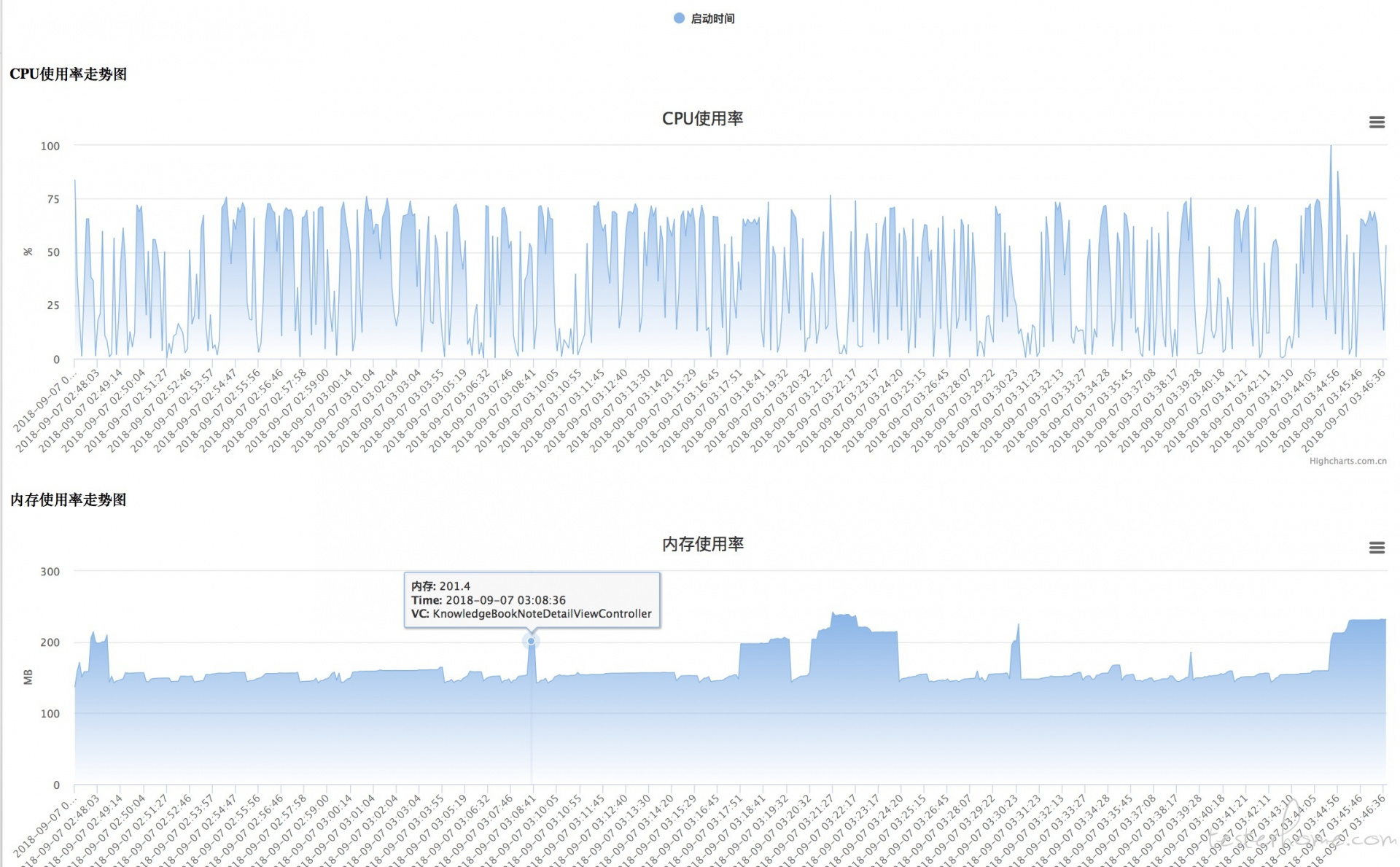【转】iOS 自动化性能采集
前言
对于iOS总体生态是比较封闭的,相比Android没有像adb这种可以查看内存、cpu的命令.在日常做性能测试,需要借助xcode中instruments查看内存、cpu等数据.
但是借助instruments比较麻烦、又不能提供命令行.在持续集成中,很难时时的监控app的性能指标.并且现在app发版一般是2周左右,留给做专项测试的时间更少了,那么做核心场景性能测试,肯定是来不及的.
所以需要借助一些自动化工具来减轻手工采集性能指标的工作量.
性能采集项
app中基本性能采集项,内存、cpu、fps、电量等,因为自动化采集中手机设备是插着电脑充电的,所以不能采集电量数据.
已有工具
- instruments是官方提供的,不能做到自动化采集
- 腾讯gt,需要在app中集成sdk,有一定的接入成本
- 第三sdk,类似腾讯gt需要在app集成,可能会有数据泄漏风险
脚本开发
上述的已有工具都不满足,在持续集成中做到自动化采集性能数据,期望的性能测试工具有一下几点:
- 方便接入
- 可生成性能报告
- 可持续化
- 数据收集精准
所以基于这几点,需要自己开发一套性能采集脚本.
使用官方提供的api做性能采集
获取内存、cpu等
#import <mach/mach.h> /**
* 获取内存
*/
- (NSString *)get_memory {
int64_t memoryUsageInByte = 0;
task_vm_info_data_t vmInfo;
mach_msg_type_number_t count = TASK_VM_INFO_COUNT;
kern_return_t kernelReturn = task_info(mach_task_self(), TASK_VM_INFO, (task_info_t) &vmInfo, &count);
if(kernelReturn == KERN_SUCCESS) {
memoryUsageInByte = (int64_t) vmInfo.phys_footprint;
NSLog(@"Memory in use (in bytes): %lld", memoryUsageInByte);
} else {
NSLog(@"Error with task_info(): %s", mach_error_string(kernelReturn));
} double mem = memoryUsageInByte / (1024.0 * 1024.0);
NSString *memtostring ;
memtostring = [NSString stringWithFormat:@"%.1lf",mem]; return memtostring;
} /**
* 获取cpu
*/
- (NSString *) get_cpu{
kern_return_t kr;
task_info_data_t tinfo;
mach_msg_type_number_t task_info_count; task_info_count = TASK_INFO_MAX;
kr = task_info(mach_task_self(), TASK_BASIC_INFO, (task_info_t)tinfo, &task_info_count);
if (kr != KERN_SUCCESS) {
return [ NSString stringWithFormat: @"%f" ,-1];
} task_basic_info_t basic_info;
thread_array_t thread_list;
mach_msg_type_number_t thread_count; thread_info_data_t thinfo;
mach_msg_type_number_t thread_info_count; thread_basic_info_t basic_info_th;
uint32_t stat_thread = 0; // Mach threads basic_info = (task_basic_info_t)tinfo; // get threads in the task
kr = task_threads(mach_task_self(), &thread_list, &thread_count);
if (kr != KERN_SUCCESS) {
return [ NSString stringWithFormat: @"%f" ,-1];
}
if (thread_count > 0)
stat_thread += thread_count; long tot_sec = 0;
long tot_usec = 0;
float tot_cpu = 0;
int j; for (j = 0; j < thread_count; j++)
{
thread_info_count = THREAD_INFO_MAX;
kr = thread_info(thread_list[j], THREAD_BASIC_INFO,
(thread_info_t)thinfo, &thread_info_count);
if (kr != KERN_SUCCESS) {
tot_cpu = -1;
//return -1;
} basic_info_th = (thread_basic_info_t)thinfo; if (!(basic_info_th->flags & TH_FLAGS_IDLE)) {
tot_sec = tot_sec + basic_info_th->user_time.seconds + basic_info_th->system_time.seconds;
tot_usec = tot_usec + basic_info_th->user_time.microseconds + basic_info_th->system_time.microseconds;
tot_cpu = tot_cpu + basic_info_th->cpu_usage / (float)TH_USAGE_SCALE * 100.0;
} } // for each thread kr = vm_deallocate(mach_task_self(), (vm_offset_t)thread_list, thread_count * sizeof(thread_t));
assert(kr == KERN_SUCCESS); NSString *tostring = nil ;
tostring = [ NSString stringWithFormat: @"%.1f" ,tot_cpu];
NSLog (@"performance cpu:%@",tostring); return tostring;
} 获取页面vc
上边收集了内存和cpu,还需要在收集数据的同时和页面对应上.这样就清楚了是当前页面的内存和cpu情况.
/**
*获取当前vc
*/
- (UIViewController *) get_vc {
UIWindow *keyWindow = [UIApplication sharedApplication].keyWindow;
__weak typeof(self) weakSelf = self;
dispatch_async(dispatch_get_main_queue(), ^{
if ([keyWindow.rootViewController isKindOfClass:[UITabBarController class]]) {
UITabBarController *tab = (UITabBarController *)keyWindow.rootViewController;
UINavigationController *nav = tab.childViewControllers[tab.selectedIndex];
DDContainerController *content = [nav topViewController];
weakSelf.vc = [content contentViewController];
}
});
return self.vc;
}
获取设备信息
/*
*获取设备名称
*/
- (NSString *) get_devicesName {
NSString *devicesName = [UIDevice currentDevice].name; //设备名称
NSLog(@"performance devicesName:%@", devicesName);
return devicesName; } /*
*获取系统版本
*/
- (NSString *) get_systemVersion{
NSString *systemVersion = [UIDevice currentDevice].systemVersion; //系统版本
NSLog(@"performance version:%@", systemVersion);
return systemVersion;
} /*
*获取设备idf
*/
- (NSString *) get_idf {
NSString *idf = [UIDevice currentDevice].identifierForVendor.UUIDString;
NSLog(@"performance idf:%@", idf);
return idf; }
数据拼接
最终要把内存、cpu等数据拼接成字典的形式,方便输出查看
输出log日志的数据格式
{
"cpu": "0.4",
"fps": "60 FPS",
"version": "11.2",
"appname": "xxxxxx",
"battery": "-100.0",
"appversion": "5.0.4",
"time": "2018-09-07 11:45:24",
"memory": "141.9",
"devicesName": "xxxxxx",
"vcClass": "DDAlreadPaidTabListVC",
"idf": "8863F83E-70CB-43D5-B6C7-EAB85F3A2AAD"
}
开启子线程采集
开一个子线程定时采集数据
/*
* 性能采集子线程
*/ - (void) performancethread {
NSThread *thread = [[NSThread alloc] initWithBlock:^{
NSLog(@"performance ======get performance======"); [self get_fps]; while (true) {
DDPerformanceModel *model = [DDPerformanceModel new];
model.time=[self get_time];
model.appname=[self get_appname];
model.appversion=[self get_appversion];
model.idf =[self get_idf];
model.devicesName =[self get_devicesName];
model.version = [self get_systemVersion ];
model.vcClass = NSStringFromClass([self get_vc].class);
model.memory = [self get_memory];
model.battery = [self get_battery];
model.cpu = [self get_cpu];
model.fps = self.percount; NSString *json = [model modelToJSONString]; // printf(" getperformance %s\r\n", [json UTF8String]);
NSLog(@"getperformance model %@", json);
sleep(5);
}
}];
[thread start]; NSLog(@"performance ======continue mainblock======");
}
初始化性能采集
AppDelegate.m文件中didFinishLaunchingWithOptions方法中用户各种初始化操作,可以在第一行初始化性能采集,
这样app启动以后就可以定时采集数据
- (BOOL)application:(UIApplication *)application didFinishLaunchingWithOptions:(NSDictionary *)launchOptions {
[[getperformance new] performancethread];//获取性能数据
}
性能采集日志存储
一般来说日志存储都是写入到本地log日志,然后读取.但是有两个问题
- 需要读写文件代码,对于不熟悉oc的人来说比较难
- 因为是定时采集,文件IO操作频繁
所以不考虑存储本地log日志的方式,可以在代码中打印出数据,通过截获当前设备运行的日志获取数据.
模拟器可以使用xcrun simctl命令获取当前设备运行日志,
真机用libimobiledevice获取日志
xcrun simctl spawn booted log stream --level=debug | grep getperformance
输出log日志的数据格式,这块做了json美化,每歌几秒在控制台就打印一次
{
"cpu": "0.4",
"fps": "60 FPS",
"version": "11.2",
"appname": "xxxxxx",
"battery": "-100.0",
"appversion": "5.0.4",
"time": "2018-09-07 11:45:24",
"memory": "141.9",
"devicesName": "xxxxxx",
"vcClass": "DDAlreadPaidTabListVC",
"idf": "8863F83E-70CB-43D5-B6C7-EAB85F3A2AAD"
}
如果获取多次数据可以使用shell脚本把命令放到后台,定时写入到logpath中
nohup xcrun simctl spawn booted log stream --level=debug >${logpath} &
代码插入到工程中
因为在持续集成中,每次打取的代码都是不带性能测试代码,这些代码是单独写到文件中.在编译项目前,用shell把代码插入到工程中,这样打出来的包才能有采集性能数据功能.
scriptrootpath=${2}
AddFiles=${2}"/GetPerformance/performancefiles"
localDDPerformanceModelh=${scriptrootpath}"/GetPerformance/performancefiles/DDPerformanceModel.h"
localDDPerformanceModelm=${scriptrootpath}"/GetPerformance/performancefiles/DDPerformanceModel.m"
localgetperformanceh=${scriptrootpath}"/GetPerformance/performancefiles/getperformance.h"
localgetperformancem=${scriptrootpath}"/GetPerformance/performancefiles/getperformance.m"
addfiles(){
echo "删除${projectaddpath}中的原性能采集文件"
rm -rf ${DDPerformanceModelh}
rm -rf ${DDPerformanceModelm}
rm -rf ${getperformanceh}
rm -rf ${getperformancem}
echo "复制文件到${projectaddpath}路径"
cp ${localDDPerformanceModelh} ${projectaddpath}
cp ${localDDPerformanceModelm} ${projectaddpath}
cp ${localgetperformanceh} ${projectaddpath}
cp ${localgetperformancem} ${projectaddpath}
}
性能数据绘制
在手工和自动化使用插入性能测试代码的app,如果截获性能数据后,可以对数据做性能数据绘制.
用Higcharts或者echarts绘制性能走势图

如何在持续集成中使用
monkey和UI自动化中使用,最终会发送一份性能报告.
Demo代码
已经把性能代码脱了主项目,可在Demo代码中编译,github地址:https://github.com/xinxi1990/iOSPerformanceTest
原文: https://testerhome.com/topics/16064
最后
虽然iOS生态封闭,但是对于开发者和测试者还是有一些空间可以利用的.
[腾讯 TMQ] iOS 电量测试实践
https://testerhome.com/topics/10666
【转】iOS 自动化性能采集的更多相关文章
- 【Android测试】【随笔】性能采集工具——小松鼠诞生记
◆版权声明:本文出自胖喵~的博客,转载必须注明出处. 转载请注明出处:http://www.cnblogs.com/by-dream/p/4945066.html 起因 去年刚加入TX的时候,我便接手 ...
- 一招让 IOS 自动化化快的飞起
前言 最近在做IOS自动化测试,IOS的Appium环境都配置OK,Demo脚本运行没有问题,多开执行没有问题,IOS安卓统一平台调度集成没有问题,可以进行自动化测试.课时真正执行用例时发现个严重问题 ...
- 【iOS Instrument性能优化集】
iOS Instrument性能优化集 1.UIImage缓存取舍 在项目代码中看到大量使用如下代码: UIImage使用 在Main Thread中发现不同动画场景中Image IO 开销和耗时所占 ...
- 初识ios自动化(一)
Appium进行自动化测试有两个好处: 1. Appium在不同平台中使用了标准的自动化APIs,所以在跨平台时,不需要重新编译或者修改自己的应用. 2. Appium支持Selenium WebDr ...
- iOS app性能优化的那些事
iPhone上面的应用一直都是以流畅的操作体验而著称,但是由于之前开发人员把注意力更多的放在开发功能上面,比较少去考虑性能的问题,可能这其中涉及到objective-c,c++跟lua,优化起来相对 ...
- iOS程序性能优化
iOS程序性能优化 一.初级 使用ARC进行内存管理 在iOS5发布的ARC,它解决了最常见的内存泄露问题.但是值得注意的是,ARC并不能避免所有的内存泄露.使用ARC之后,工程中可能还会有内存泄露, ...
- iOS应用性能调优的25个建议和技巧【转】
转载自:http://blog.jobbole.com/37984/ 首页 最新文章 资讯 程序员 设计 IT技术 创业 在国外 营销 趣文 特别分享 更多 > - Navigation - ...
- iOS应用性能调优的4个建议和技巧
任何一个能在用户手机屏幕中占有一席之地的iOS app都包含3个关键因素:想法好.设计出色.性能卓越.本文将分享一些iOS应用性能调优的4个建议和技巧. Tip #1:把图片资源压缩到最小. i ...
- iOS 程序性能优化
前言 转载自:http://www.samirchen.com/ios-performance-optimization/ 程序性能优化不应该是一件放在功能完成之后的事,对性能的概念应该从我们一开始写 ...
随机推荐
- Python基础3 函数、递归、内置函数
本节内容 1. 函数基本语法及特性 2. 参数与局部变量 3. 返回值 嵌套函数 4.递归 5.匿名函数 6.函数式编程介绍 7.高阶函数 8.内置函数 温故知新 1. 集合 主要作用: 去重 关系测 ...
- Node 在 Centos7 系统下的安装
1,下载二进制包 https://nodejs.org/zh-cn/download/ 根据自己的需求选择对应的版本,不推荐使用源码包,容易出现错误 2,上传到 linux 服务器 3, 解 ...
- Appium -选择、操作元素2
选择元素的方法 根据xpath 在Appium中,我们没法使用css,因为css是web专用的 Appium支持xpath来定位元素 对于一些比较复杂的元素的定位,我们可以用它 driver.find ...
- sql server 字符串字节长度
SQL Server 字符个数,字节长度,len不是你想要的字节数,datalength才能得到字节数 select len('娜娜123') ,datalength('娜娜123') 5 ...
- java 父类引用指向子类对象---动态绑定
知识点: 1.java 中父类引用指向子类对象时动态绑定针对的只是子类重写的成员方法: 2.父类引用指向子类对象时,子类如果重写了父类的可重写方法(非private.非 final 方法),那么这个对 ...
- Windows下如何查看某个端口被谁占用
开发时经常遇到端口被占用的情况,这个时候总是很令人抓狂,知道被哪个进程占用还好,结束就是了,要是不知道我们该怎么办呢? 我告诉大家一个方法,^_^. 1. 开始—->运行—->cmd,或者 ...
- SRM-供应商关系管理
https://wiki.scn.sap.com/wiki/display/SRM 供应商关系管理 SAP SRM 跳到元数据结束 由前成员创建,最后由Tamas Koban于2019年1 ...
- How to Pronounce TH after N or Z
How to Pronounce TH after N or Z Share Tweet Share Tagged With: Linking Consonant to Consonant The T ...
- sass实战演练01 - 外部文件引用和变量
SASS是什么? 目前前端开发中css已经是公认的”前端程序员必须掌握”的知识,最早的css编写都是手工一条条写出来的,工作量大.不利于维护. 而sass的存在使得css开发可以像写代码一样最终生成一 ...
- 创建一个Maven Web应用程序
1 在Eclipes创建maven,首先File new ,在other 中找到Maven,Maven Project,下一步选择WebApp,创建Maven工程名字,完成 2 在新建的Maven工程 ...
